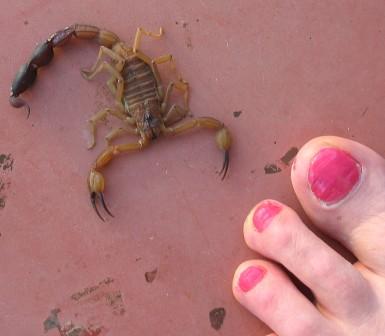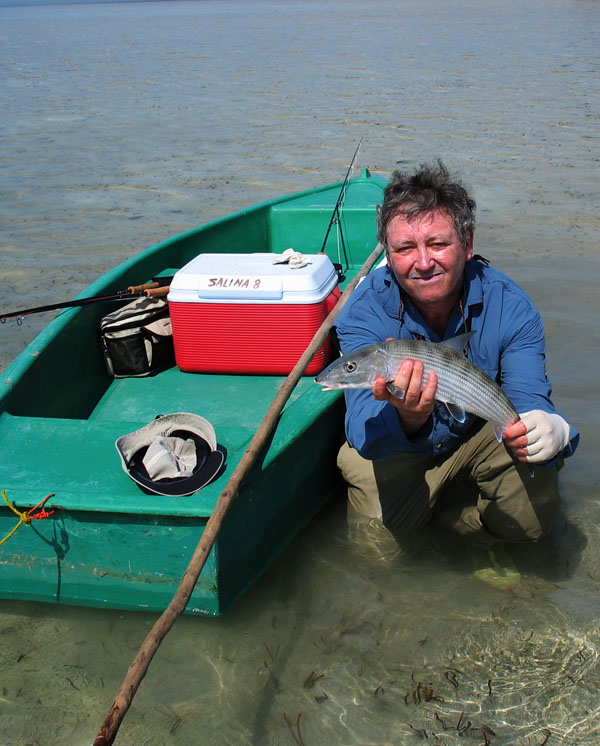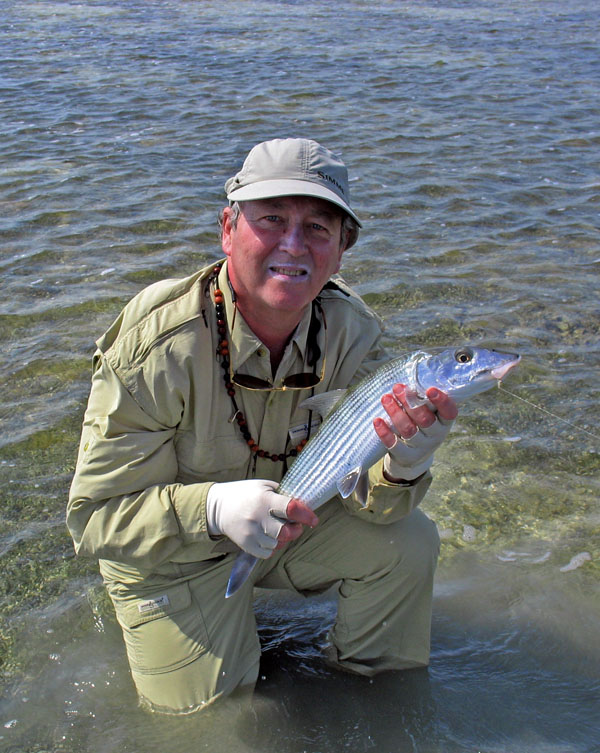
Cuban Saltwater Fly Fishing
An article by John Leggett.
Just over a year ago, a fishing friend, who had often taken a yearly break abroad pursuing saltwater fish species with a fly rod, telephoned me in an excited state.
We had often talked of my intention to join him on one of his expeditions but had never actually got our act together. John, he said, “I have just come back from Cuba, and have experienced the most amazing fishing. Start saving now-you just have to come back with me next year!
After such an enthusiastic endorsement, I determined to join my friend and started saving. During the course of the next few months, we acquired other interested friends, and our party grew to 5-one female and 4 male. During this time, I started to hunt out equipment, much of it coming from the American market on eBay. In particular, I needed some saltwater resistant reels, which had a much larger line capacity than those I had been used to when pursuing UK saltwater species, and eBay provided these with a little perseverance. These reels all came by chance with tropical lines attached. Such lines are necessary for the warm water conditions, as the relatively soft braided cores of lines normally used in the UK would be too floppy, so these stiffer lines usually have a harder mono core. This can be a little off-putting if you test out the set-ups in this country, as they feel very odd, but as soon as you are out in 35+ degrees of heat with the glaring sun, they work effortlessly.
The main species we were pursuing were bonefish, but we knew there would be barracuda, tarpon, snook and permit if we were lucky. We started to draw up a list of other pieces of kit and clothing required, and the fly tying box began to acquire a lot of materials it had not accommodated before, in an array of different colours. I set about tying the flies that research and plenty of reading had indicated that were needed.
I had never encountered many of the flies before and their names where alien to me. Pink puffs, crazy charlies, bonefish bitters, crab patterns, etc. Although I enjoyed the whole excitement of assembling everything, I must confess to having taken particularly enjoyment in tying these new and varied patterns on saltwater hooks much larger than the trout patterns I would normally tie. Everything assembled, and with just over 48hrs to go, I checked the list of kit and started to pack only to discover that my 4 piece 9-foot rods in their tubes would just not fit into my ordinary luggage. They were just too long. I had done a quick mental calculation and thought the 4 piece rods would easily fit into my ordinary luggage, but with each rod tube being padded at both ends, the smallest tube measured 32inches and would not fit in any circumstances.
A last-minute call to Fishtec provided the answer in the form of their X-stream Cargo bag, which arrived the day before departure. Panic over, even though I had to dig a bit deeper into my pocket to solve the crisis!
We had a very early start to catch our direct Virgin Atlantic 9 hour flight from Gatwick to Havana, which was faultless. However as we landed in Havana, I noticed some stray dogs running around on the landing strip, and thought this was a little unusual. I discovered in the next 24-48 hours that this unusual sight on the runway was just the beginning of what turned out to be the most amazing adventure I had ever experienced. We were transported about 2 hours South East from Havana in a taxi, which had an enormous crack in the front windscreen, and no seat belts.
If we thought this was scary, the country’s main highway, along which we travelled had large potholes, which had to be negotiated once in a while, and large areas of the surface would just be missing from time to time. Large old Russian built lorries could be seen ahead weaving around these obstacles. To add to this chaos, we would occasionally encounter a horse and cart coming towards us on the same side of the road, which would involve yet another minor detour. Once in a while, the locals would run out from the side of the road with pineapples, bananas and cigars for sale. To add to all of this, many of the road intersections would have large numbers of Cubans wanting lifts, some coming well into the carriageway to make their presence known.
We subsequently heard that this great long highway had been designed by Fidel Castro to double as a landing strip for aircraft in time of war! Having built the 6-lane highway, I can only assume that they found they could neither afford to paint the white lines on it or maintain any area of it.
It became quickly clear that the Cubans just get on with what they have. There’s no point in complaining because nobody can do anything about it anyway! The confusion is exacerbated due to a total lack of signs or any directions. We arrived at our fishing Lodges, which were basic but adequate for a fishing holiday. Each Lodge was designed to accommodate 2 people. Our permits to fish on the Nature reserve (approx 1.5 million acres) of the Zapata peninsular, close to the infamous Bay of Pigs, were quickly sorted, and we went to unpack our belongings, followed by a meal prepared by the resident cook.
We all then went to our Lodges to prepare for an early start with our kit the following morning. The first time I went to the loo, I was aware of several pairs of eyes tracking my moves. These were mostly small geckos, and a couple of frogs, which had taken refuge under the toilet roll holder. I objected to none of these, as long as they stayed in the bathroom, but have to confess to ejecting the frogs later in the week when they came into the sleeping quarters. We all went to sleep in great anticipation of the fishing to come.
I was awoken by a muffled sound-possibly a scream- at about 4.00 am, and was then kept awake by the buzzing mosquitoes for the rest of the night (note for another trip: MOSQUITO NET!). I arose properly just before 6.00 am, and rechecked my kit- On this the first day, I was planning to set up two 9 ft rods, one for an eight-weight line, and one for a nine weight. Both lines were floaters, and a tapered Rio bonefish cast would eventually be tied on. I would also take a spare rod with me for Just in case.
We had to travel just over an hour to the actual fishing each morning, so could not assemble everything where we were staying but had to do so when we arrived at the departure point for the boats. As we came out of our Lodges to assemble for breakfast, we discovered that our female companion had got out of bed during the night to attend a call of nature, and trodden on a large brown scorpion, which promptly stung her on the toe.
This had evidently been the scream, which had woken me! Fortunately, her husband who was another of our fishing companions is a Doctor, and he monitored the situation.
I found out later that there are no poisonous insects or snakes on Cuba, but I’m not sure how I would have felt if I had been stung in the middle of the night! (We were also told on our return to the UK that generally if the scorpion is brown, large and has very obvious pincers, you’re probably OK. The dangerous ones tend to be small and black! I hope none of you reading this will ever need to recall this information!!).
Breakfast completed, and gasps of shock/horror at the scorpion tale and thanking God it wasn’t me, we assembled our kit, and applied vast quantities of high factor sun cream for the day ahead. This became an essential routine each day, as the high factor sun creams are messy, so it is a good idea to apply it before thoroughly washing your hands of the smell. (Clothing which is UV filtering is a must to avoid burning out on the flats).
We drove down to the jetty to meet our guides, who were to be our companions for the week and introduced ourselves. My guide, Juan Carlos, spoke very good English, which was a great advantage as I learned a lot from him about Cuba and the fishing in the area. Some of the others were not so fortunate, as a couple of the guides had very limited English; hence even simple communication was difficult. Juan Carlos told me that he had been trained in Russia for 2 years as a Hydrogeology technician, returning to Cuba fully trained. He worked in this field for a while but then decided to go for a better job. That better job was a waiter, which seemed very odd, but it became quickly clear that such jobs are much sought after in Cuba because of the possibility of earning cash tips. Basic wages in the vast majority of jobs in Cuba, even highly qualified ones, are very low, hence trying to find a job that will attract cash tips. He was now employed as a Warden on the vast Nature Reserve, which we were fishing, with the opportunity to guide from time to time, and the chance to earn tips.
The area we were fishing was mostly vast shallow areas ranging from 6inches to 3 feet deep, broken up by small mangrove islands. Each of us set off in a different direction, and after 10minutes or so, we were in a most amazing landscape surrounded by all manner of bird life-Ospreys, Ibis, Pink Flamingos. The first thing to be mastered was standing upright in the shallow drafted flat bottomed skiff, just about 4 feet wide, with the guide pushing this little skiff along with a long pole from the rear.
As the area over which you are travelling is very shallow, and you tend to be looking in the distance, the skiff often catches the bottom, thus sending you forward. With the next push on the pole, you are projected backwards, and so it goes on. I think if I go again, I will practice the art of standing on top of a large bouncy ball! That might prepare me! Our first day, which turned out to be the windiest day of all of our fishing days, set the same pattern each day in that the winds in the mornings would always be much lighter than in the afternoon. This made it difficult to spot fish easily on the first day, especially so that with any new form of fishing, you have to acclimatise yourself to the environment and know what you are looking for.
Towards the end of the morning, and totally absorbed in this amazing landscape, my guide pointed out a disturbance in the distance which we thought were bonefish. As we drew closer to the area we had seen the disturbance, my guide called out with much urgency. Out went my fly, and as I slowly retrieved it, it was taken with great force. Small barracuda was the next cry from my guide, in great excitement. (I found out as the week progressed that he got far more excited than me when he spotted fish, so I had to calm him down on many occasions!)
So here was my first fish- a small Barracuda of about 1 ½ lb. Nothing to write home about, but exciting nevertheless. Later in the week, we were chasing Barracuda in excess of 30lbs, and wire traces then became a necessity, but I did manage to land this first one without its teeth slicing the leader. Even with that first small Barracuda, I thought how evil it looked! We were having trouble spotting bonefish, so we went into a large sheltered lagoon and stopped briefly for lunch and a drink- we were also thoughtfully supplied with copious amounts of bottled water in a cool box, which was necessary because of the high temperatures, and loss of fluids through perspiration. After lunch, we set off to search the lagoon for more bonefish. Within a short while, my guide spotted something in the distance and poled towards what he had seen. He then got extremely excited “Permit, Permit” he shouted and quickened the polling rate. I then saw what he had seen, and it was an amazing site- about a dozen permit, line abreast, doing the equivalent of a head and tail rise in harmony. These fish have a very spike-like single dorsal fin, which trails down into the water after them as they go down to the bottom in search of crabs etc. They gave the appearance of a row of dustbin lids on edge rolling over and over, but with this long trailing dorsal fin behind. I had put down my 8wt rod which had been set up specifically for bonefish and picked up my 9wt rod which I had fortunately prepared with a weighted crab pattern. I was lucky to get a good cast first time in front of the pack, and they all rushed to inspect my aquasure crab as it sunk to the bottom. I had been told not to do much at this point, so I tweaked the fly a little, and the line tightened. I was also told not to strike in the usual way but to strip-strike, as a high lift of the rod at this point tends not to set the hook properly. In a split second, one of the permits was taking off to the far horizon with my fly, at which point, I just had to lift the rod. It didn’t seem to make any difference, but the fish ran out of steam initially at about 120 yards. During the time of this first run, I could see we were in for a bit of a tussle, so I hopped out of the boat, into about 15inches of water. As the fish had taken so much line, I wanted to play it off the reel, recovering line when I could.
As I went to turn the reel handle to recover the line, I discovered that the reel was jammed! The fish then decided to have another run of an additional 20-30 yards, and I quickly worked out that the fish could take the line off the reel, but I couldn’t recover any, as the mechanism was jammed I made the decision now to play the fish by recovering line and letting it fall in the water around me. I often play trout like this, and by now I had about 150 yards of line out, but I really had no other option. I thought I had enough to contend with, as every run pulled the thin backing line through my fingers, causing some not inconsiderable discomfort because this was the only way I could now control the fish. Another problem arose to contend with. About 10 minutes into the fight, I spotted a large grey shape shadowing the permit around. I asked my guide what it was, and he became very excited again. “Large barracuda!” he screamed, “I will deal with it”.
He launched himself into the water in the direction of the Barracuda armed only with his long pole, and after much thrashing around, the barracuda decided to call it a day and melted away. I am told that barracuda will often take fish as they are being played, even sizeable permit. The permit ran around our skiff, incomplete circles about 7 or 8 times, but eventually, after 40 minutes, we were able to bring him to hand.
Although this was a fish of only about 8 lbs, it was immensely powerful, and because of its shape, very difficult to bring under control. I later learned that this was the only permit which had been caught that month in these flats, although a few had been spotted. The guide was particularly pleased because it gave him bragging rights with the other guides. Most of these guides were older than him, and I detected a little jealousy on our triumphant arrival at the jetty at the end of the day.
Although we carried on looking for bonefish on that first day, we saw very few, but amazingly found another group of 3 much larger permit creating what is called mud. The fish swim around in tight circles, disturbing the bottom, in order to stir up the crabs and other crustaceans residing there.
Once again, my guide spotted this mud at some distance, and although I cast right into the middle of it my fly was not taken. We thought it likely that the fish simply couldn’t see my fly in the coloured water, but I can only assume they can see their normal prey, so why not mine?
We returned to base that first day, to hear tales from the others in our group about what they had seen. Most had at least seen bonefish, and some had caught them. There was much excitement at my capture of the permit, and I felt particularly pleased to have seen so many of these wonderful fish. Many in the group never even saw a permit for the week we were fishing over the flats. I had to endure much ribbing about the capture of the permit, as this was the only one caught-I told them, all in good humour, that I was going to start a Permit Club, and thus far, there was only one member!
As a postscript to my jammed reel, we examined it on our return that evening. It transpired that the clutch mechanism was in the wrong way round-it had been set for a left-hand wind, whereas I set all of my reels for a right-hand wind. This puzzled me at first because I knew that I had set the whole thing correctly when the backing and line went on the reel. Then I remembered that just before we left, I showed this particular reel to an engineering friend of mine, as we have an ongoing idea to make a fly fishing reel, incorporating all of the desirable features of a perfect fly reel. He had taken the mechanism apart in front of me to examine the clutching device on this reel, but I had not noticed that he had obviously replaced the central clutch the wrong way round! I have yet to see him!!
Over the next 4 days we saw and caught lots of bonefish, and also saw plenty of barracuda and other species, particularly rays. Most of the bonefish we saw were easily scared, so stealth was required. If the bonefish were that is swimming along with their very pointed tail and dorsal fin sticking out of the water, stopping now and again to grub in the bottom for food- we would leave the skiff behind, and wade, keeping our profile as low as we could.
A fly would be carefully dropped in their path and tweaked as they approached it. The line would tighten, and as the fish felt the resistance, it would take off. On all runs, the 30 metres of fly line would be gone in an instant, and varying amounts of backing would accompany. The average size of the bonefish was about 5lbs. On one day, one of the group caught a fish of about 9lbs which had its dorsal fin bitten away, almost certainly by a barracuda. Essential bits of kit to help with fish spotting were a good pair of Polaroid sunglasses and a long brimmed hat with a dark underside. All of our hats featured a fold-down rear flap to cover the ears and neck-the sun on these flats is relentless and very powerful.
Although it is fairly easy to spot bonefish when they are tailing, many of them are spotted just swimming through the water without breaking the surface. The water is gin clear, and has the most incredible colour when viewed at a distance, spotting the fish which are not tailing becomes quite an art. You try to spot a fish before your guide, which is not easy, as they have eyes like hawks.
On our 3rd day, we came across one huge lagoon with, I guess, literally thousands of bonefish. They were swimming around in packs of about 100. Quite a spectacle! Needless to say, that was the day I caught the most. This was good because you could experiment with flies and retrieves knowing that there were plenty more fish if a certain approach had not worked.
On our very last days fishing, two of us were taken by a larger boat with an outboard engine to the edge of the reef, some 50 minutes away. The outboard engine had to be rigged with a piece of wood and string to lift it sufficiently out of the water to stop it fouling the bottom as it went along, across the shallow flats. Another piece of Cuban ingenuity! The anchor was a piece of old engine casing tied on with a piece of rope, which looked as if it had come ashore as flotsam. The edge of the reef was, in effect, where the sea came into this vast coral bed, referred to as flats. The periphery of this coral bed has its own micro-system of deep channels linking it to the sea. We had no real idea where we were going and were told by the Cuban guides that we were going to fish the obviously, this word lost a little in the translation from Channels
When we got there, we could see what they were on about. Essentially, at high and low water, the water in these channels was slack, but as the tide turned, it raced through the deep channels in and out from the main sea.
This gave rise to a different type of fishing and additional species. We had little idea of what to expect as we pottered through the mangrove-lined channels. I had seen a couple of fair-sized barracuda, so as we chugged along, I had my barracuda set up in my hand. Out of the corner of my eye, I caught sight of some dark shapes coming towards us in one of these channels.
At the same time, my guide screamed “Tarpon, Tarpon. Cast, Cast. I instinctively flicked out my fly and no sooner had it sunk below the surface than the rod was almost ripped out of my hand as a Tarpon took off towards the sea with my fly.
After a run of about 60 yards, it then came up to the surface. I have often talked about fish tail-walking, but this one had to be seen to be believed. As it did so, its gill plates, which sounded as if they were made of plates of thin steel, clattered like a suit of armour falling off a stand in a museum.
The fish looked prehistoric. It jumped a second time and then threw the hook. I really didn’t mind losing that fish; it was so exciting.
Shortly after this, my friend David in the other boat hooked a tarpon, which promptly ran towards him and under his boat. This took him so much by surprise that it pulled him in!!!!!!!!! I wished I had seen it but never the less we heard the splash of him going in and in the commotion that followed we went to see what had happened only to find him crawling out of the water back into the boat.
I dare not print what he said, but I think it was related to his incompetence or rather lack of it. The decision was made to change location if for no other reason but for David to dry and cool off !!!!!! Along the way, we pursued some snook and a very large barracuda, but none of them actually took the fly, even though they showed much interest.
A dozen shark of about 60/70lbs was spotted with one much larger lemon shark of about 150lbs. My guide was very keen to go after these with a fly, so I put on the largest and most colourful fly in my box and cast out. I had 5 or 6 follows to it. One came to within 3 feet or so of the boat before turning away.
My heart was certainly in my mouth on a number of occasions. I secretly prayed that they wouldn’t take my fly, as we really weren’t equipped to cope with a shark, even a small one. But that’s Cuba for you!
When we eventually met up with David again, he said that he had actually hooked into a solitary passing shark, taking about 150yds of line before throwing the hook.
We both came back on that last day having not boated a single fish between us, but having had the time of our lives! That’s fishing.
On our last night at the Lodges, we invited all of our guides to a meal, and that seemed to go down very well with them.
It seemed to us that all the Cubans we came across were poor but content with their lot, as everyone had nothing more than anyone else.
The gesture of a meal out was quite something for them, and we enjoyed their company immensely.
At the end of our final days fishing, we all gave our guides their tips for the week and various bits which we had brought with us, as we had been told that there is precious little for the ordinary person to buy in the shops so pens, pencils, toothbrushes etc are considered like gold dust. My guide had looked longingly at a pair of long-nosed electrical pliers that I had used during the week which I had paid the grand sum of £1.50 before I went to Cuba, reasoning that if I lost them overboard, it would not be a great financial loss.
He told me that Cubans would just not be able to buy such things, as the country is unable to import items in the way we do in the UK. They are just not available. His eyes lit up as I handed these pliers over to him at the end of the week. A small matter to me, but a great one for him.
We said our final farewells, left our lodges and drove the two hours back to Havana through the Cuban countryside. We were now getting good at spotting banana crops, papaya, lemon trees and the like.
Our last night in Cuba was spent in the Fox and Crow nightclub listening to some Cuban Jazz. Our return flight was in the afternoon of the following day, so a couple of us got up early and spent a couple of hours looking around Old Havana in the morning- a fascinating place containing a very opulent Capitol Building, a nearby Cigar Factory (sorry chaps, to burst the bubble, but dusky maidens do not roll the cigars on the inside of their thighs), the Museum of the Revolution, the National Flamenco School, to name a few. I wish we had had more time to discover even more about the Cuban culture.
In our short tour, one thing that struck us was the lack of shops, which reinforced the general non-availability of goods. We had real trouble trying to buy a bottle of water!
5 very happy people boarded the return Virgin Atlantic flight. We had all experienced a most amazing week of fishing, wildlife and culture.
I am already saving for another trip in the hope that it will all be there again next year. Sadly, if the facilities are improved and the area commercialised, the costs will rapidly rise. I live in hope!







